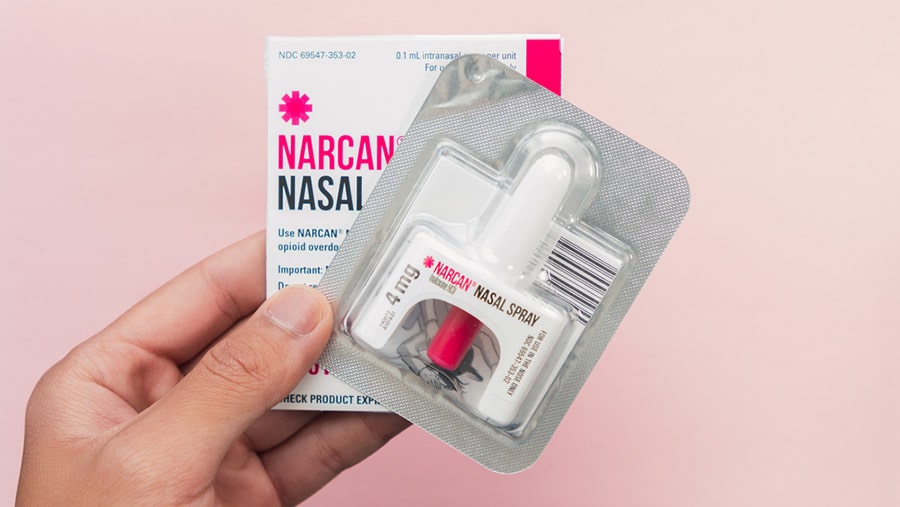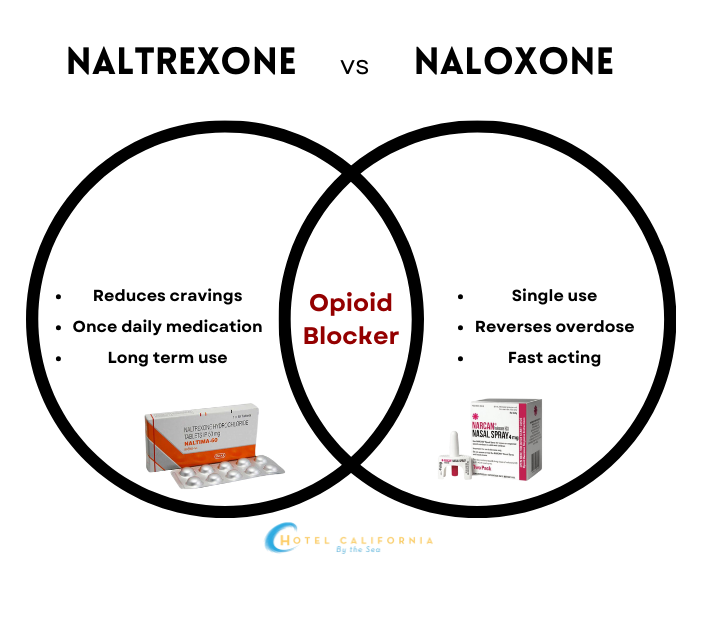Naltrexone vs Naloxone. What is the difference between these two opioid-blocking medications?
Opioid use disorder has been an ongoing public health epidemic in the United States over the past decades. In fact, the majority of drug overdoses now involve some sort of opioid. There are many factors that can put people at risk for opioid overdose including, low drug tolerance, intravenous route of administration, recreational substance use, depression and the development of other mental health conditions. Naloxone, known by the brand name Narcan, and naltrexone, known by the brand name Vivitrol, are two common medication treatments used against opioid use disorder. They are opioid blockers that can help reverse the effects of opioids.

Naltrexone is FDA-approved to treat opioid use disorder and alcohol use disorder. Naloxone is FDA-approved for managing emergency opioid overdose, post-surgery to reverse the effects of opioid medications given for pain and to newborns to decrease opioid effects that were given to pregnant women before delivery. Despite both medications being opioid blockers, they are in fact used for two different purposes and used differently when treating opioid use disorder. Naloxone is used to reverse the effects of opioid overdoses immediately. While naltrexone is used to block the effects and cravings of opioids throughout the entirety of addiction treatment.

Naltrexone vs Naloxone
Naltrexone
- Brand name Vivitrol.
- Naltrexone comes as a tablet or an injection that is administered intramuscularly.
- Naltrexone can help treat opioid use disorder and alcohol use disorder.
- Naltrexone is a long-acting opioid antagonist. It blocks the high you experience from opioids and helps to prevent the patient from relapsing.
- Naltrexone blocks opioid receptors and works by decreasing the amount of dopamine and natural opioids that are released in the body. Activities such as drinking alcohol and taking opioids can cause the body to release a neurotransmitter called dopamine. This brain chemical produces feelings of happiness, pleasure and relaxation. When endogenous opioids are released into the body, they also promote the release of dopamine. Naltrexone blocks these dopamine releases and blocks the feelings of euphoria that are experienced when people drink alcohol or take opioid drugs.
- Naltrexone works by attaching to opioid receptors in the brain to prevent cravings and block the rewarding effects produced by opioids. It can stay effective for up to 24 hours and with an injectable, can last up to 30 days.
- Naltrexone should only be taken once opioids have been fully removed from the system. It should not be used on patients who have active use of opioids.
- Naltrexone is not an opioid and is not addictive. It cannot cause withdrawal symptoms when medication use has suddenly stopped or drastically decreased.
- Naltrexone is a medication often used as a part of medication-assisted treatment (MAT) and as a form of long-term medication management for those who have opioid use disorder or alcohol use disorder. It is prescribed as part of treatment in addition to individual and group therapies. A prescription is needed in order to receive this medication.
- One dose of naltrexone can cost between $30-50.
- Naltrexone does not treat opioid overdose. It does not work fast enough to be effective during an opioid overdose situation.
- Common side effects of naltrexone include nausea, stomach ache, dizziness and headache.
Naloxone
- Brand name Narcan
- Naloxone comes in an injectable and nasal spray, which was designed for ease of use for administering in emergency situations. Each emergency dose of naloxone whether an injectable or nasal spray, is a pre-measured dose specific for helping to reverse opioid overdose.
- Naloxone is strictly used to treat opioid overdose by reversing its effect immediately when administered.
- Naloxone is a short-term opioid blocker. It is not designed for long-term use and is generally known as emergency medication for opioid overdose. It acts quickly to reverse opioid overdose. When the body experiences pain, it naturally releases opioids. These opioids attach to opioid receptors throughout the body to reduce feelings of pain. When your body releases too much opioid, it can slow down breathing so much that you can completely stop breathing and cause an overdose. Naloxone works by quickly attaching to opioid receptors to block effects and push the body into immediate withdrawal.
- Naloxone works by immediately binding to and removing the opioid receptors.
- Naloxone can take effect between 30-90 minutes.
- Naloxone is considered a drug antidote for opioid overdose.
- Naloxone is an opioid receptor antagonist.
- Naloxone does not produce a high and can be given in multiple doses.
- Naloxone is only effective in those who have taken opioids. It will not help reverse an overdose of other types of drugs other than opioids.
- Naloxone is available over the counter without a prescription and has become more accessible in an attempt to help assist in the opioid overdose crisis.
- One dose of naloxone can cost around $50.
- Naloxone can also be found as an active ingredient in other medications such as suboxone.
- Common side effects of naloxone use include anxiety, restlessness, irritability, muscle aches, chills, weakness, stomach pain, vomiting and nausea.
Check Your Insurance Coverage for FREE
Find out if your insurance covers addiction treatment in minutes. We accept most insurance!
Which medication is right for you?
There are many factors to take into consideration when treating opioid use disorder. Naloxone and naltrexone are widely used medications for treating opioid use disorder. But they serve different purposes for treatment. Naloxone is used for emergency situations to quickly reverse opioid overdose. While naltrexone is a long-term treatment to block opioid effects that can be administered every few days or once a month depending on the concentration of the medication. Other factors to consider are the costs and side effects of each medication. Other medications used in the treatment of opioid use disorder include suboxone and methadone.
Reach out to Hotel California by the Sea
We specialize in treating addiction and other co-occurring disorders, such as PTSD. Our Admissions specialists are available to walk you through the best options for treating your addiction.
Looking for treatment of Opioid Use Disorder?
Naloxone is a medication most often used to immediately treat opioid overdose. Anyone who has used any type of opioid will be able to reverse their overdose with naloxone. It is often used by police officers, emergency medical professionals, non-emergency first responders, families of opioid users as well as caregivers. If the person is not overdosing on opioids, naloxone will have no effect on them.
Naltrexone is a medication that disrupts the chemical feedback loop in the body’s reward system, which inhibits feelings of euphoria and relaxation. It is a medication often used for long-term treatment to help reduce drug cravings. However, before administration of this drug, the person must be completely free of opioids from their body. If the drug is taken while opioids remain in the body, the person could face the effects of precipitated withdrawal.
Opioid use disorder can be a difficult disease to overcome. Treatments such as naloxone and naltrexone can help treat different aspects of drug addiction. Through a professional behavioral health treatment program such as Hotel California by the Sea, clients will have a greater chance at sobriety and recovery. We provide services at all levels of care including detox, residential, and outpatient programs.
Our unique treatment methods include cognitive behavioral therapy, dialectical behavioral therapy, and EMDR therapy. Our treatment facilities also include medication treatments such as naloxone and naltrexone. Both medications have proven successful in treatment in addition to individual and group therapies that address co-occurring mental health conditions. Hotel California by the Sea provides exceptional care, support and resources for our clients in all levels of addiction and recovery.
References:
https://www.goodrx.com/conditions/opioid-use-disorder/naloxone-vs-naltrexone
https://anrclinic.com/blog/naloxone-vs-naltrexone
https://www.bicyclehealth.com/opioid-education/naloxone-vs-naltrexone
https://www.verywellhealth.com/naloxone-vs-naltrexone-similarities-and-differences-7853201
https://www.oarhealth.com/resources/naltrexone-vs-naloxone-whats-the-difference
